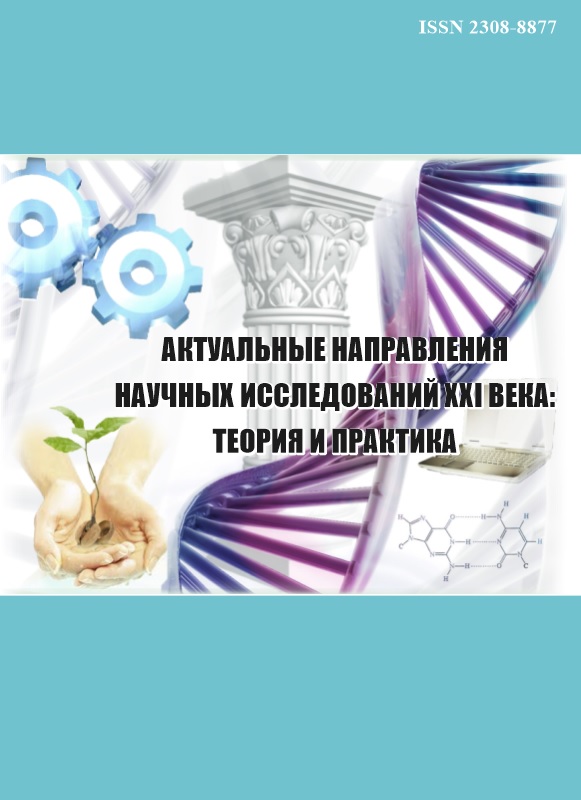Green spaces in cities perform many different useful functions: noise-proof, dust-absorbing, have an impact on the processes of insolation, they enrich the air with phytoncides, and also play a huge aesthetic role, which has a beneficial effect on the psychological state of people. In matters of planning and improvement of various objects, much attention is paid to landscaping. Green spaces can be used in planning and architectural solutions. Therefore, it is necessary to take a more careful approach to gardening and landscaping. This is especially true for objects where children are staying for a long time. This object is the Palace of creativity of children and youth of the city of Voronezh, the territory of which served for research. Such objects must be maintained in an appropriate sanitary and aesthetic condition, which will improve the quality of perception of the territory. Unsettled areas of institutions have a negative impact on the mood and General well-being of children and their parents, and may also contain a potential danger to the person at the time of stay. In particular, the unsatisfactory condition of plantings, roads, and small architectural forms is dangerous. Therefore, it is necessary to assess the state of the territory and recommend measures for landscaping and improvement, taking into account the requirements, as well as to develop an architectural and planning solution. As a result, a landscape and environmental assessment was performed, which consists in determining the type of spatial structure, assessing the state of plantings, aesthetic and sanitary assessments, the stage of digression, and recreational capacity. Based on the results of the study, functional zoning was developed. The balance of the territory was determined and it was found that the percentage of greenery does not meet the required standards. The condition of the plantings on the site was assessed as satisfactory. Therefore, it is necessary to Supplement the number of plantings with the most stable types of tree and shrub vegetation, taking into account their decorative and aesthetic value. It is necessary to properly carry out the improvement of the object, to develop an architectural and planning composition of the territory of the Palace of creativity of children and youth.
green spaces, stability, landscape and environmental assessment, functional zoning, assortment of plants, architectural and planning solution, landscaping.
ВВЕДЕНИЕ
Во многих городах мира в бедственном положении находятся объекты озеленения – сады, парки, скверы. Благоустройство городов – одна из важных задач формирования комфортной городской среды [1]. Важную роль в этом играют зеленые насаждения.
Зеленые насаждения и городские леса – это неотъемлемая часть градостроительной структуры города Воронежа и главная часть его экологического каркаса. Они входят в систему жизнеобеспечения города, как первостепенный средообразующий и средозащитный фактор, обеспечивающий комфортность и качество среды обитания человека, и как обязательный и важный элемент городского ландшафта. Озеленение в Воронеже является также основным социальным, стабилизирующим аспектом, снижая напряженность и конфликтность окружающей среды, и способствует устойчивому развитию города.
Воронеж обладает достаточно обедненной планировочной структурой, в которой практически отсутствует единая общегородская система озеленения. Озеленение города хаотично, не имеет четкого планировочного каркаса и единой пространственно-композиционной идеи. Внутригородская растительность города представлена парками, скверами, садами, бульварами, рядовыми примагистральными уличными посадками, а также озеленением территорий различных учреждений, объектов общего и ограниченного пользования и специального назначения.
Среди общественных и культурно-бытовых учреждений микрорайонов наибольшие по площади участки имеют дворцы творчества детей и молодежи, которые относятся к объектам ограниченного пользования. Для озеленения территорий таких объектов характерны насаждения типа небольших садов или скверов, площадь которых составляет 1,5 – 2,0 га [2]. Процент озелененности территорий культурно-бытовых объектов составляет 20-40% [5].
1. Taking an ecosystem services approach for a new national park system in China Resources, Conservation and Recycling, Volume 137, October 2018, Pages 136-144Siyuan He, Yang Su, Lei Wang, Louise Gallagher, Hongguang Cheng
2. Teodoronskiy, V.S. Ob'ekty landshaftnoy arhitektury [Tekst]: Uchebnoe posobie dlya studentov spec. 260500. /V.S. Teodoronskiy, I.O. Bogovaya; - M.: MGUL, 2003 - 330 s.
3. Kruglyak, V.V. Urboekologiya i monitoring sredy [Tekst]: Uchebnoe posobie. Ch. 1 / V.V. Kruglyak, N.P. Kartashova; VGLTA. - Voronezh, 2004. - 71 s.
4. Kartashova, N. P. Landscaping and beautification of urban areas [Tekst] Ozelenenie i blagoustroystvo gorodskih territoriy / N. P. Kartashova // The Third European Conference on Agriculture : proceeding of the conference (Austria, Vienna, November 1, 2014). - Vienna, 2014. - C. 45-50. - Bibliogr.: s. 50 (2 nazv.).
5. Bogovaya, I.O. Ozelenenie naselennyh mest [Tekst]: Ucheb. posobie dlya vuzov. / I.O. Bogovaya, V.S. Teodoronskiy; - M.: Agropromizdat, 1990. - 239 s.
6. Turner, T. Open space planning in London [Text] / T. Turner // Strategic Planning Advice for London, October, 1988. - London, 1993. - P. 366-386.










